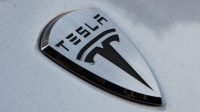It didn't make the news here but it seems that a fire in a crashed Tesla S vehicle destroyed it, happily with no fatal outcome. It would seem probable that the crash cause an internal or external short-circuit of the battery housed in the front.
Note that petrol/gasoline and diesel fuel are also hazardous but cars are exempted from hazard placards for liquid fuels on the assumption that firefighters know of the danger which is not the case with electric cars containing hundreds of kg of Li.
To transport in Europe anything containing >1 kg Li metal, the outside container should be labelled:
European Labeling in Accordance with EC Directives
Hazard Symbols: F C
Risk Phrases:
R 14/15 Reacts violently with water liberating extremely flammable gases.
R 34 Causes burns.
Safety Phrases:
S 8 Keep container dry.
S 43H In case of fire, use dry chemical, soda ash, lime or sand. (Do not use water or foam).
S 45 In case of accident or if you feel unwell, seek medical advice immediately (show the label where
possible).
Hazard Symbols: F C
Risk Phrases:
R 14/15 Reacts violently with water liberating extremely flammable gases.
R 34 Causes burns.
Safety Phrases:
S 8 Keep container dry.
S 43H In case of fire, use dry chemical, soda ash, lime or sand. (Do not use water or foam).
S 45 In case of accident or if you feel unwell, seek medical advice immediately (show the label where
possible).
2013-11-02_142846.png2013-11-02_142913.png2013-11-02_142422.png
Does this apply to cars using (not transporting?) batteries?



Comment